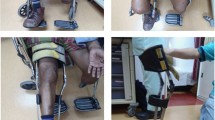Abstract
Poliomyelitis affect more than 85% of children aged 3 months to 3 years, commonly known as infantile paralysis sequelae in China. But the general trend is that millions of polio patients left over in mainland China will gradually enter the middle and old age, and their surgical treatment, functional assistance, and lifestyle need guidance from doctors.
In the last 20 years, there were no academic conference or training course focusing on poliomyelitis sequelae held by orthopedic science community. Doctors under 45 years of age hardly understand the surgical treatment for this kind of lower limb deformities! Until now, only one team of Qinsihe orthopedics insist working on surgical treatment for patients of poliomyelitis sequelae in China. In December 2017, a surgical database was established in Qinsihe Orthopedics Institute, including 23,310 cases of polio sequela, accounting for over 67% in this database. It may be the largest group of surgical data of polio case in the world.
The lesions of poliomyelitis are in the thoracolumbar gray matter most commonly, and the distribution of the lesions was closely related to the clinical manifestations of limb paralysis. Children who suffered from extensive and severe muscle paralysis, whose joint or limb in a certain fixed position, the joint ligament relax, fascia and muscle contracture, genu varum or genu valgum, and pelvic tilt can usually be seen. With the increase of age, the compensatory function of the limbs weakens, and abnormal weight-bearing of the affected limbs, and the degeneration of the bones and joints is earlier than normal people. As a result of limb dysfunction, the amount of exercise is significantly lower, the body is obese, osteoporosis is also common, and limb disability is developed and exaggerated at the time of presentation. It is called post-poliomyelitis syndrome (PPS). With the improvement of economy and the prolongation of life expectancy, more and more patients with senile poliomyelitis sequelae desire to improve their functioning.
Paralysis and deformity of foot and ankle are common in poliomyelitis sequela. Up to December 2017, is the database includes 19 of top 30 surgical procedures for foot and ankle deformity, such as 5111 times of talocalcaneal joint arthrodesis, 4973 times of Achilles tendon extension, 2475 times of plantar aponeurolysis, 2435 times of peroneal longus tendon transfer for the Achilles tendon, 1456 times of triple arthrodesis, and 961 times of the basal part of first metatarsal osteotomy.
The range of orthopedic surgery involves every aspect of the motor system, and decision-making with especial emphasizes on the whole concept of treating patients for good and make them independent in their daily activities. There are more than 200 kinds of surgical methods, which must be carried out according to individual characteristics; the postoperative rehabilitation must be carried out properly, and then maximum functional improvement can be achieved for the sequelae of different ages, different types, and deformities. Expensive medical examinations, equipment, and new surgical instruments have been widely used in orthopedic departments, but the surgical treatment of poliomyelitis sequelae rarely requires those top medical equipment and devices. Good therapeutic effects still need the surgeons’ dialectical thinking, the whole idea, the scientific decision, the rich practical experience, the skilled surgical technique, and the dedication to relieve patients’ suffering.
Creep-squatting deformity is a special type with severe paralysis and loss of function, which is rarely reported in the literature. Patients with creep-squatting deformity cannot stand and walk, it is difficult for them to take care of themselves, learning and employment are limited, let alone marriage is frustrated, and they have become the burden of their family and society. A total of 681 patients with creep-squatting deformity were unable to stand up and only crawl on the ground and move with wheelchairs for long distance, including 564 cases of poliomyelitis sequelae.
The basic principles of lower limb lengthening and functional reconstruction of poliomyelitis sequela is as follows: correct the deformities, stable the relaxed joints, balance pelvis, and reconstruction of muscle strength. In order to make the crawling patient stand up and walk, first we must correct the deformity, restore the gravity line, and stabilize the joints.
All the experience and methods of dealing with complex limb deformities secondary to poliomyelitis sequela are in this section.
Access this chapter
Tax calculation will be finalised at checkout
Purchases are for personal use only
Similar content being viewed by others
Author information
Authors and Affiliations
Editor information
Editors and Affiliations
Rights and permissions
Copyright information
© 2020 Springer Nature Singapore Pte Ltd.
About this chapter
Cite this chapter
Qin, S. et al. (2020). Lower Limb Deformities in Poliomyelitis Sequelae. In: Qin, S., Zang, J., Jiao, S., Pan, Q. (eds) Lower Limb Deformities. Springer, Singapore. https://doi.org/10.1007/978-981-13-9604-5_5
Download citation
DOI: https://doi.org/10.1007/978-981-13-9604-5_5
Published:
Publisher Name: Springer, Singapore
Print ISBN: 978-981-13-9603-8
Online ISBN: 978-981-13-9604-5
eBook Packages: MedicineMedicine (R0)




